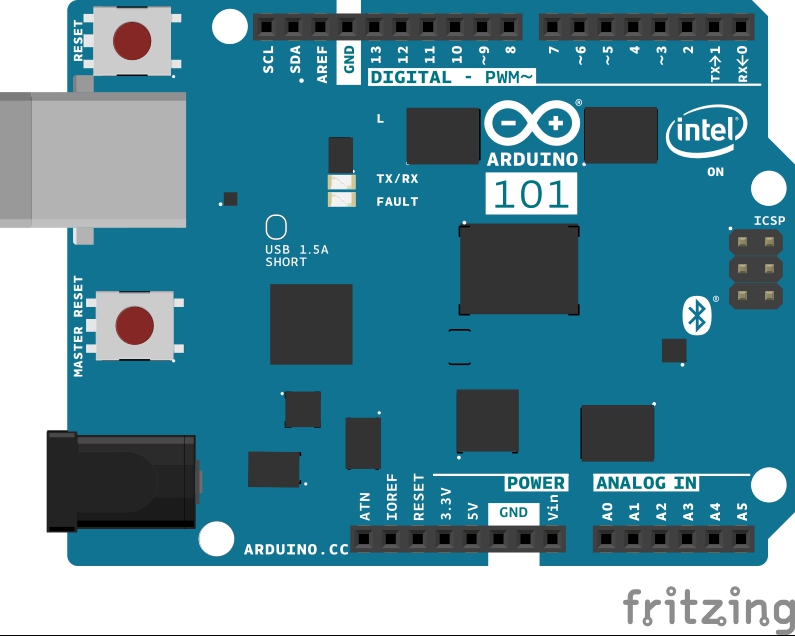Eğitimler
CurieTimer1Interrupt
Bu öğretici ile mikrodenetleyicide bulunan zamanlayıcılardan birini kullanmayı öğrenirsiniz. Kütüphane Zamanlayıcı 1'i kullanır ve bu eğitici yerleşik LED'i değiştirmek için değişken aralıklarla kesmenin nasıl ayarlanacağını gösterir. Kesme, delay () işlevinden çıkmanın tek yoludur ve bu çizimde, LED'in geçişi için geçici olarak çıkış gecikmesini - kod yürütme akışını durduran - göstermek için kullanılır, daha sonra devam eder kesildiği yerden. Son etki, aynı yanıp sönme oranına sahip 10 saniyelik yanıp sönen bir bloktur ve her 10 saniyede bir dört adımda artırılır.
Gerekli Donanım
Devre

Bu öğreticiyi kullanmak için ek donanıma gerek yoktur.
Yazılım Temelleri
Kütüphaneler
CurieTimerOne .h, mikro denetleyicinin Zamanlayıcı 1'ine erişim sağlayan kütüphanedir. Bu kütüphane, kronometrenin bir kesinti yapılmadan önce saydığı mikrosaniye sayısını ayarlamaya izin verir. Kesme belirli bir işlevi (geri arama işlevi) çağıracak şekilde yapılandırılabilir ve her kesme bir sayacı artırır. Aynı kütüphane, görev döngüsü ve periyot uzunluğu tamamen özelleştirilebilir bir PWM sinyali üretmek için kullanılır.
Fonksiyonlar
timedBlinkIsr () - kesinti ileri sürüldüğünde çizim yürütmesinin geçirildiği işlevdir. "!" İle değiştirilen açma / kapatma değişkenini kullanarak D13 üzerindeki LED'in durumunu değiştirir. (DEĞİL) operatör her çağrıda.
Kod
Kod, #define SERIAL_PORT_LOG_ENABLE 1 yorumunda veya açıklamasında kullanılabilecek bir seri monitör özelliğiyle yazılmıştır.
Sketch: Timer1Interrupt.ino
This sketch demonstrates the usage of the Curie Timer One Library.
It uses timer-1 to blink the onboard LED, pin 13, at different
intervals (speed) in four steps.
You can see the time interval and the number of interrupt counted
in 10 seconds if you keep serial logging active, but this may require
a MASTER_RESET to reprogram the board.
Blinking of the LED will start only when you open the Serial Monitor
unless you comment the "#define SERIAL_PORT_LOG_ENABLE 1"; don't
forget to uncomment "CurieTimerOne.restart(time);"
created by Intel
Modified 14 March 2016
by Simone Majocchi
This example code is in the public domain.
*/
#include "CurieTimerOne.h"
// Comment the following statement to disable logging on serial port.
#define SERIAL_PORT_LOG_ENABLE 1
const int oneSecInUsec = 1000000; // A second in mirco second unit.
bool toggle = 0; // The LED status toggle
int time; // the variable used to set the Timer
void timedBlinkIsr() // callback function when interrupt is asserted
{
digitalWrite(13, toggle);
toggle = !toggle; // use NOT operator to invert toggle value
}
void setup() {
#ifdef SERIAL_PORT_LOG_ENABLE
Serial.begin(115200); // initialize Serial communication
while (!Serial); // wait for the serial monitor to open
#endif
// Initialize pin 13 as an output - onboard LED.
pinMode(13, OUTPUT);
}
void loop() {
for (int i = 1; i < 9; i = i * 2) {
// We set a blink rate of 1000000, 500000, 250000, 125000 microseconds
time = oneSecInUsec / i; // time is used to toggle the LED is divided by i
CurieTimerOne.start(time, &timedBlinkIsr); // set timer and callback
#ifdef SERIAL_PORT_LOG_ENABLE
Serial.print("The blink period: ");
Serial.println(time);
#endif
delay(10000); // 10 seconds of delay, regularly 'interrupted' by the timer interrupt
#ifdef SERIAL_PORT_LOG_ENABLE
Serial.print("Total number of ticks in 10 seconds: ");
Serial.println(CurieTimerOne.rdRstTickCount()); // Reads and Resets tick count
Serial.println("----");
#endif
// Uncomment the following line if the serial logging is disabled
// CurieTimerOne.restart(time); // Restarts Timer
}
}
